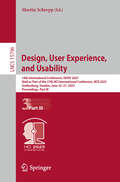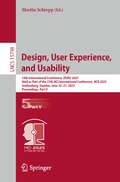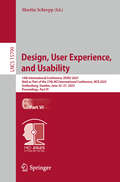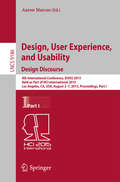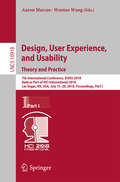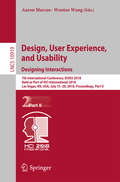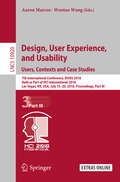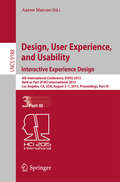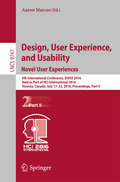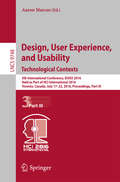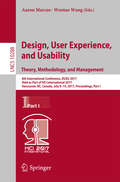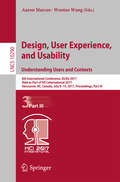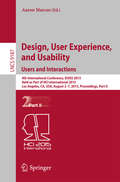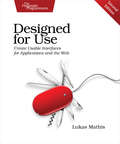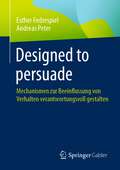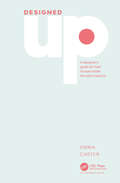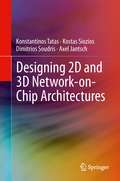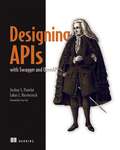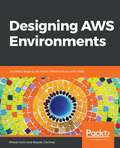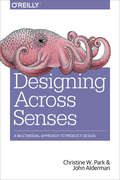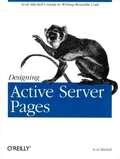- Table View
- List View
Design, User Experience, and Usability: 14th International Conference, DUXU 2025, Held as Part of the 27th HCI International Conference, HCII 2025, Gothenburg, Sweden, June 22–27, 2025, Proceedings, Part III (Lecture Notes in Computer Science #15796)
by Martin SchreppThis six-volume set LNCS 15794-15799 constitutes the refereed proceedings of the 14th International Conference on Design, User Experience, and Usability, DUXU 2025, held as part of the 27th International Conference on Human-Computer Interaction, HCII 2025, in Gothenburg, Sweden, during June 22-27, 2025. The total of 1430 papers and 355 posters included in the HCII 2025 proceedings was carefully reviewed and selected from 7972 submissions.The six volumes cover the following topics:Part I: Information design and visualization; emotional interaction and persuasive design; and interactive systems and user behavior.Part II: UX design and evaluation methodologies; inclusive design and accessible experiences; and product and industrial design.Part III: Design and the digital transmission of culture; design for arts and creativity; and designing for health and therapeutic experiences.Part IV: Consumer experience and service design; design and evaluation of technology-enhanced learning; and UX in automotive and transportation.Part V: Design education and professional practice; and human-centered design and interactive experiences.Part VI: AI and the future of UX design; and UX in AI and emerging technologies.
Design, User Experience, and Usability: 14th International Conference, DUXU 2025, Held as Part of the 27th HCI International Conference, HCII 2025, Gothenburg, Sweden, June 22–27, 2025, Proceedings, Part IV (Lecture Notes in Computer Science #15797)
by Martin SchreppThis six-volume set LNCS 15794-15799 constitutes the refereed proceedings of the 14th International Conference on Design, User Experience, and Usability, DUXU 2025, held as part of the 27th International Conference on Human-Computer Interaction, HCII 2025, in Gothenburg, Sweden, during June 22-27, 2025. The total of 1430 papers and 355 posters included in the HCII 2025 proceedings was carefully reviewed and selected from 7972 submissions.The six volumes cover the following topics:Part I: Information design and visualization; emotional interaction and persuasive design; and interactive systems and user behavior.Part II: UX design and evaluation methodologies; inclusive design and accessible experiences; and product and industrial design.Part III: Design and the digital transmission of culture; design for arts and creativity; and designing for health and therapeutic experiences.Part IV: Consumer experience and service design; design and evaluation of technology-enhanced learning; and UX in automotive and transportation.Part V: Design education and professional practice; and human-centered design and interactive experiences.Part VI: AI and the future of UX design; and UX in AI and emerging technologies.
Design, User Experience, and Usability: 14th International Conference, DUXU 2025, Held as Part of the 27th HCI International Conference, HCII 2025, Gothenburg, Sweden, June 22–27, 2025, Proceedings, Part V (Lecture Notes in Computer Science #15798)
by Martin SchreppThis six-volume set LNCS 15794-15799 constitutes the refereed proceedings of the 14th International Conference on Design, User Experience, and Usability, DUXU 2025, held as part of the 27th International Conference on Human-Computer Interaction, HCII 2025, in Gothenburg, Sweden, during June 22-27, 2025. The total of 1430 papers and 355 posters included in the HCII 2025 proceedings was carefully reviewed and selected from 7972 submissions.The six volumes cover the following topics:Part I: Information design and visualization; emotional interaction and persuasive design; and interactive systems and user behavior.Part II: UX design and evaluation methodologies; inclusive design and accessible experiences; and product and industrial design.Part III: Design and the digital transmission of culture; design for arts and creativity; and designing for health and therapeutic experiences.Part IV: Consumer experience and service design; design and evaluation of technology-enhanced learning; and UX in automotive and transportation.Part V: Design education and professional practice; and human-centered design and interactive experiences.Part VI: AI and the future of UX design; and UX in AI and emerging technologies.
Design, User Experience, and Usability: 14th International Conference, DUXU 2025, Held as Part of the 27th HCI International Conference, HCII 2025, Gothenburg, Sweden, June 22–27, 2025, Proceedings, Part VI (Lecture Notes in Computer Science #15799)
by Martin SchreppThis six-volume set LNCS 15794-15799 constitutes the refereed proceedings of the 14th International Conference on Design, User Experience, and Usability, DUXU 2025, held as part of the 27th International Conference on Human-Computer Interaction, HCII 2025, in Gothenburg, Sweden, during June 22-27, 2025. The total of 1430 papers and 355 posters included in the HCII 2025 proceedings was carefully reviewed and selected from 7972 submissions.The six volumes cover the following topics:Part I: Information design and visualization; emotional interaction and persuasive design; and interactive systems and user behavior.Part II: UX design and evaluation methodologies; inclusive design and accessible experiences; and product and industrial design.Part III: Design and the digital transmission of culture; design for arts and creativity; and designing for health and therapeutic experiences.Part IV: Consumer experience and service design; design and evaluation of technology-enhanced learning; and UX in automotive and transportation.Part V: Design education and professional practice; and human-centered design and interactive experiences.Part VI: AI and the future of UX design; and UX in AI and emerging technologies.
Design, User Experience, and Usability: 4th International Conference, DUXU 2015, Held as Part of HCI International 2015, Los Angeles, CA, USA, August 2-7, 2015, Proceedings, Part I (Lecture Notes in Computer Science #9186)
by Aaron MarcusThe three-volume set LNCS 9186, 9187, and 9188 constitutes the proceedings of the 4th International Conference on Design, User Experience, and Usability, DUXU 2015, held as part of the 17th International Conference on Human-Computer Interaction, HCII 2015, in Los Angeles, CA, USA, in August 2015, jointly with 13 other thematically similar conferences. The total of 1462 papers and 246 posters presented at the HCII 2015 conferences were carefully reviewed and selected from 4843 submissions. These papers address the latest research and development efforts and highlight the human aspects of design and use of computing systems. The papers accepted for presentation thoroughly cover the entire field of Human-Computer Interaction, addressing major advances in knowledge and effective use of computers in a variety of application areas. The total of 132 contributions included in the DUXU proceedings were carefully reviewed and selected for inclusion in this three-volume set. The 61 papers included in this volume are organized in topical sections on design thinking, user experience design and usability methods and tools, DUXU management and practice, emotional and persuasion design, and storytelling, narrative and fiction in DUXU.
Design, User Experience, and Usability: 7th International Conference, DUXU 2018, Held as Part of HCI International 2018, Las Vegas, NV, USA, July 15-20, 2018, Proceedings, Part I (Lecture Notes in Computer Science #10918)
by Aaron Marcus Wentao WangThe three-volume set LNCS 10918, 10919, and 10290 constitutes the proceedings of the 7th International Conference on Design, User Experience, and Usability, DUXU 2018, held as part of the 20th International Conference on Human-Computer Interaction, HCII 2018, in Las Vegas, NV, USA in July 2018. The total of 1171 papers presented at the HCII 2018 conferences were carefully reviewed and selected from 4346 submissions. The papers cover the entire field of human-computer interaction, addressing major advances in knowledge and effective use of computers in a variety of applications areas.The total of 165 contributions included in the DUXU proceedings were carefully reviewed and selected for inclusion in this three-volume set. The 55 papers included in this volume are organized in topical sections on design thinking, methods and practice, usability and user experience evaluation methods and tools, and DUXU in software development.
Design, User Experience, and Usability: 7th International Conference, DUXU 2018, Held as Part of HCI International 2018, Las Vegas, NV, USA, July 15-20, 2018, Proceedings, Part II (Lecture Notes in Computer Science #10919)
by Aaron Marcus Wentao WangThe three-volume set LNCS 10918, 10919, and 10290 constitutes the proceedings of the 7th International Conference on Design, User Experience, and Usability, DUXU 2018, held as part of the 20th International Conference on Human-Computer Interaction, HCII 2018, in Las Vegas, NV, USA in July 2018. The total of 1171 papers presented at the HCII 2018 conferences were carefully reviewed and selected from 4346 submissions. The papers cover the entire field of human-computer interaction, addressing major advances in knowledge and effective use of computers in a variety of applications areas. The total of 165 contributions included in the DUXU proceedings were carefully reviewed and selected for inclusion in this three-volume set. The 50 papers included in this volume are organized in topical sections on design, education and creativity, GUI, visualization and image design, multimodal DUXU, and mobile DUXU.
Design, User Experience, and Usability: 7th International Conference, DUXU 2018, Held as Part of HCI International 2018, Las Vegas, NV, USA, July 15–20, 2018, Proceedings, Part III (Lecture Notes in Computer Science #10920)
by Aaron Marcus Wentao WangThe three-volume set LNCS 10918, 10919, and 10290 constitutes the proceedings of the 7th International Conference on Design, User Experience, and Usability, DUXU 2018, held as part of the 20th International Conference on Human-Computer Interaction, HCII 2018, in Las Vegas, NV, USA in July 2018. The total of 1171 papers presented at the HCII 2018 conferences were carefully reviewed and selected from 4346 submissions. The papers cover the entire field of human-computer interaction, addressing major advances in knowledge and effective use of computers in a variety of applications areas. The total of 165 contributions included in the DUXU proceedings were carefully reviewed and selected for inclusion in this three-volume set. The 60 papers included in this volume are organized in topical sections on emotion, motivation, and persuasion design, DUXU and children, DUXU in automotive and transport, and DUXU in culture and art.
Design, User Experience, and Usability: Design Discourse
by Aaron MarcusThe three-volume set LNCS 9186, 9187, and 9188 constitutes the proceedings of the 4th International Conference on Design, User Experience, and Usability, DUXU 2015, held as part of the 17th International Conference on Human-Computer Interaction, HCII 2015, in Los Angeles, CA, USA, in August 2015, jointly with 13 other thematically similar conferences. The total of 1462 papers and 246 posters presented at the HCII 2015 conferences were carefully reviewed and selected from 4843 submissions. These papers address the latest research and development efforts and highlight the human aspects of design and use of computing systems. The papers accepted for presentation thoroughly cover the entire field of Human-Computer Interaction, addressing major advances in knowledge and effective use of computers in a variety of application areas. The total of 132 contributions included in the DUXU proceedings were carefully reviewed and selected for inclusion in this three-volume set. The 61 papers included in this volume are organized in topical sections on design thinking, user experience design and usability methods and tools, DUXU management and practice, emotional and persuasion design, and storytelling, narrative and fiction in DUXU.
Design, User Experience, and Usability: Design Thinking and Methods
by Aaron MarcusThe three-volume set LNCS 9746, 9747, and 9748 constitutes the proceedings of the 5th International Conference on Design, User Experience, and Usability, DUXU 2016, held as part of the 18th International Conference on Human-Computer Interaction, HCII 2016, in Toronto, Canada, in July 2016, jointly with 13 other thematically similar conferences. The total of 1287 papers presented at the HCII 2016 conferences were carefully reviewed and selected from 4354 submissions. These papers address the latest research and development efforts and highlight the human aspects of design and use of computing systems. The papers accepted for presentation thoroughly cover the entire field of Human-Computer Interaction, addressing major advances in knowledge and effective use of computers in a variety of application areas. The total of 157 contributions included in the DUXU proceedings were carefully reviewed and selected for inclusion in this three-volume set. The 49 papers included in this volume are organized in topical sections on design thinking; user experience design methods and tools; usability and user experience evaluation methods and tools.
Design, User Experience, and Usability: Designing Pleasurable Experiences
by Aaron Marcus Wentao WangThe three-volume set LNCS 10288, 10289, and 10290 constitutes the proceedings of the 6th International Conference on Design, User Experience, and Usability, DUXU 2017, held as part of the 19th International Conference on Human-Computer Interaction, HCII 2017, in Vancouver, BC, Canada, in July 2017, jointly with 14 other thematically similar conferences. The total of 1228 papers presented at the HCII 2017 conferences were carefully reviewed and selected from 4340 submissions. These papers address the latest research and development efforts and highlight the human aspects of design and use of computing systems. The papers accepted for presentation thoroughly cover the entire field of Human-Computer Interaction, addressing major advances in knowledge and effective use of computers in a variety of application areas. The total of 168 contributions included in the DUXU proceedings were carefully reviewed and selected for inclusion in this three-volume set. LNCS 10288: The 56 papers included in this volume are organized in topical sections on design thinking and design philosophy; aesthetics and perception in design; user experience evaluation methods and tools; user centered design in the software development lifecycle; DUXU education and training. LNCS 10289: The 56 papers included in this volume are organized in topical sections on persuasive and emotional design; mobile DUXU; designing the playing experience; designing the virtual, augmented and tangible experience; wearables and fashion technology. LNCS 10290: The 56 papers included in this volume are organized in topical sections on information design; understanding the user; DUXU for children and young users; DUXU for art, culture, tourism and environment; DUXU practice and case studies.
Design, User Experience, and Usability: Interactive Experience Design
by Aaron MarcusThe three-volume set LNCS 9186, 9187, and 9188 constitutes the proceedings of the 4th International Conference on Design, User Experience, and Usability, DUXU 2015, held as part of the 17th International Conference on Human-Computer Interaction, HCII 2015, in Los Angeles, CA, USA, in August 2015, jointly with 13 other thematically similar conferences. The total of 1462 papers and 246 posters presented at the HCII 2015 conferences were carefully reviewed and selected from 4843 submissions. These papers address the latest research and development efforts and highlight the human aspects of design and use of computing systems. The papers accepted for presentation thoroughly cover the entire field of Human-Computer Interaction, addressing major advances in knowledge and effective use of computers in a variety of application areas. The total of 132 contributions included in the DUXU proceedings were carefully reviewed and selected for inclusion in this three-volume set. The 64 papers included in this volume are organized in topical sections on designing the social media experience, designing the learning experience, designing the playing experience, designing the urban experience, designing the driving experience, designing the healthcare patient's experience, and designing for the healthcare professional's experience.
Design, User Experience, and Usability: Novel User Experiences
by Aaron MarcusThe three-volume set LNCS 9746, 9747, and 9748 constitutes the proceedings of the 5th International Conference on Design, User Experience, and Usability, DUXU 2016, held as part of the 18th International Conference on Human-Computer Interaction, HCII 2016, in Toronto, Canada, in July 2016, jointly with 13 other thematically similar conferences. The total of 1287 papers presented at the HCII 2016 conferences were carefully reviewed and selected from 4354 submissions. These papers address the latest research and development efforts and highlight the human aspects of design and use of computing systems. The papers accepted for presentation thoroughly cover the entire field of Human-Computer Interaction, addressing major advances in knowledge and effective use of computers in a variety of application areas. The total of 157 contributions included in the DUXU proceedings were carefully reviewed and selected for inclusion in this three-volume set. The 67 papers included in this volume are organized in topical sections on emotion, motivation, and persuasion design; DUXU in learning and education; games and gamification; culture, language and DUXU; DUXU for social innovation and sustainability; usability and user experience studies.
Design, User Experience, and Usability: Technological Contexts
by Aaron MarcusThe three-volume set LNCS 9746, 9747, and 9748 constitutes the proceedings of the 5th International Conference on Design, User Experience, and Usability, DUXU 2016, held as part of the 18th International Conference on Human-Computer Interaction, HCII 2016, in Toronto, Canada, in July 2016, jointly with 13 other thematically similar conferences. The total of 1287 papers presented at the HCII 2016 conferences were carefully reviewed and selected from 4354 submissions. These papers address the latest research and development efforts and highlight the human aspects of design and use of computing systems. The papers accepted for presentation thoroughly cover the entire field of Human-Computer Interaction, addressing major advances in knowledge and effective use of computers in a variety of application areas. The total of 157 contributions included in the DUXU proceedings were carefully reviewed and selected for inclusion in this three-volume set. The 41 papers included in this volume are organized in topical sections on mobile DUXU; DUXU in information design and visualization; DUXU in virtual and augmented reality; DUXU for smart objects and environments.
Design, User Experience, and Usability: Theory, Methodology, and Management
by Aaron Marcus Wentao WangThe three-volume set LNCS 10288, 10289, and 10290 constitutes the proceedings of the 6th International Conference on Design, User Experience, and Usability, DUXU 2017, held as part of the 19th International Conference on Human-Computer Interaction, HCII 2017, in Vancouver, BC, Canada, in July 2017, jointly with 14 other thematically similar conferences. The total of 1228 papers presented at the HCII 2017 conferences were carefully reviewed and selected from 4340 submissions. These papers address the latest research and development efforts and highlight the human aspects of design and use of computing systems. The papers accepted for presentation thoroughly cover the entire field of Human-Computer Interaction, addressing major advances in knowledge and effective use of computers in a variety of application areas. The total of 168 contributions included in the DUXU proceedings were carefully reviewed and selected for inclusion in this three-volume set. LNCS 10288: The 56 papers included in this volume are organized in topical sections on design thinking and design philosophy; aesthetics and perception in design; user experience evaluation methods and tools; user centered design in the software development lifecyc≤ DUXU education and training. LNCS 10289: The 56 papers included in this volume are organized in topical sections on persuasive and emotional design; mobile DUXU; designing the playing experience; designing the virtual, augmented and tangible experience; wearables and fashion technology. LNCS 10290: The 56 papers included in this volume are organized in topical sections on information design; understanding the user; DUXU for children and young users; DUXU for art, culture, tourism and environment; DUXU practice and case studies.
Design, User Experience, and Usability: Understanding Users and Contexts
by Aaron Marcus Wentao WangThe three-volume set LNCS 10288, 10289, and 10290 constitutes the proceedings of the 6th International Conference on Design, User Experience, and Usability, DUXU 2017, held as part of the 19th International Conference on Human-Computer Interaction, HCII 2017, in Vancouver, BC, Canada, in July 2017, jointly with 14 other thematically similar conferences. The total of 1228 papers presented at the HCII 2017 conferences were carefully reviewed and selected from 4340 submissions. These papers address the latest research and development efforts and highlight the human aspects of design and use of computing systems. The papers accepted for presentation thoroughly cover the entire field of Human-Computer Interaction, addressing major advances in knowledge and effective use of computers in a variety of application areas. The total of 168 contributions included in the DUXU proceedings were carefully reviewed and selected for inclusion in this three-volume set. LNCS 10288: The 56 papers included in this volume are organized in topical sections on design thinking and design philosophy; aesthetics and perception in design; user experience evaluation methods and tools; user centered design in the software development lifecycle; DUXU education and training. LNCS 10289: The 56 papers included in this volume are organized in topical sections on persuasive and emotional design; mobile DUXU; designing the playing experience; designing the virtual, augmented and tangible experience; wearables and fashion technology. LNCS 10290: The 56 papers included in this volume are organized in topical sections on information design; understanding the user; DUXU for children and young users; DUXU for art, culture, tourism and environment; DUXU practice and case studies.
Design, User Experience, and Usability: Users and Interactions
by Aaron MarcusThe three-volume set LNCS 9186, 9187, and 9188 constitutes the proceedings of the 4th International Conference on Design, User Experience, and Usability, DUXU 2015, held as part of the 17th International Conference on Human-Computer Interaction, HCII 2015, in Los Angeles, CA, USA, in August 2015, jointly with 13 other thematically similar conferences. The total of 1462 papers and 246 posters presented at the HCII 2015 conferences were carefully reviewed and selected from 4843 submissions. These papers address the latest research and development efforts and highlight the human aspects of design and use of computing systems. The papers accepted for presentation thoroughly cover the entire field of Human-Computer Interaction, addressing major advances in knowledge and effective use of computers in a variety of application areas. The total of 132 contributions included in the DUXU proceedings were carefully reviewed and selected for inclusion in this three-volume set. The 67 papers included in this volume are organized in topical sections on users in DUXU, women in DUXU, information design, touch and gesture DUXU, mobile DUXU, and wearable DUXU.
Designed for Use: Create Usable Interfaces for Applications and the Web
by Lukas MathisThis book is for designers, developers, and product managers who are charged with what sometimes seems like an impossible task: making sure products work the way your users expect them to. You'll find out how to design applications and websites that people will not only use, but will absolutely love. The second edition brings the book up to date and expands it with three completely new chapters.Interaction design - the way the apps on our phones work, the way we enter a destination into our car's GPS - is becoming more and more important. Identify and fix bad software design by making usability the cornerstone of your design process.Lukas weaves together hands-on techniques and fundamental concepts. Each technique chapter explains a specific approach you can use to make your product more user friendly, such as storyboarding, usability tests, and paper prototyping. Idea chapters are concept-based: how to write usable text, how realistic your designs should look, when to use animations. This new edition is updated and expanded with new chapters covering requirements gathering, how the design of data structures influences the user interface, and how to do design work as a team. Through copious illustrations and supporting psychological research, expert developer and user interface designer Lukas Mathis gives you a deep dive into research, design, and implementation--the essential stages in designing usable interfaces for applications and websites.Lukas inspires you to look at design in a whole new way, explaining exactly what to look for - and what to avoid - in creating products that get people excited.
Designed to persuade: Mechanismen zur Beeinflussung von Verhalten verantwortungsvoll gestalten
by Esther Federspiel Andreas PeterDen Stromverbrauch senken, den Abfall recyclen, den «Jetzt kaufen»-Button drücken – menschliches Verhalten wird beinahe überall beeinflusst. Die Frage stellt sich deshalb, wie Mechanismen zur Beeinflussung von Verhalten erkannt und verantwortungsvoll gestaltet werden können. Vorliegendes Buch bietet einen strukturierenden Werkzeugkasten, das Persuasive Design Toolkit, der durch die Anwendung zentraler Verhaltensänderungs-Mechanismen bei digitalen oder analogen Lösungen führt. Die angewandten Design-Muster werden theoriebasiert strukturiert und in Bezug zum Botschaftssender, dem Nutzenden und der User-Journey gesetzt.Die persuasiven Design-Muster sind so konkret wie möglich und so abstrakt wie nötig gehalten, um auf breit gefächerte Kontexte wie E-Commerce, Marketing, Gesundheit oder ökologische Nachhaltigkeit anwendbar zu sein. Der Prozess bringt interdisziplinäre Teams von Produkt- und (Customer-)Experience-Designerinnen und -Designern, Marketingfachleuten, Software-Entwicklerinnen und -Entwicklern sowie Fachexpertinnen und -experten zusammen und hilft ein Produkt so zu entwickeln oder zu optimieren, dass es sowohl Nutzende als auch Unternehmen bereichert und Verhaltensziele fokussiert erreicht werden können.Der InhaltVerhalten verstehenVerhaltensänderung verstehen und gestaltenPersuasive Design ToolkitEthische Aspekte
DesignedUp: A designer’s guide on how to lead inside the tech industry
by Emma Carter"Carter’s new book, DesignedUp, is a useful guide for the modern design practitioner who sits at the intersection of the IT consultancy and agency world — someone who chooses to plot their own course across many companies’ diverse set of interests instead of being loyal to just one. In doing so, they have selected an exciting path that will bring them many heralded victories and challenging pitfalls, which Carter has aptly navigated over her impressive career. If you have been in the field for a while, I think you will find Carter’s book to be a refreshing antidote to any career doldrums you may have."— Dr. John Maeda, VP of Design and Artificial Intelligence, Microsoft "Designers have long asked for a ‘seat at the table.’ What Emma Carter has done is given them the roadmap to not only get that seat, but to redesign the table to fit what tech-driven organisations need to succeed today."— Jeff Gotthelf, Author "Lean UX" and "Sense & Respond" Are you struggling to get non-designers to understand the value of what you do? Tech companies and consultancies can feel like an inhospitable landscape for designers. Too often, design is seen as a ‘nice extra’, rather than an integral part of the process, and designers find their voice overshadowed by decision-makers who don’t understand or appreciate the power of design. DesignedUp will help you eliminate obstacles and become a design leader who can effectively influence everyone from engineers to C-level execs. By sharing perspectives, methods, frameworks and hero stories from global Tech & Design leaders, including Rebecca Parsons, CTO at Thoughtworks; Andreas Markdalen, Global Chief Creative Officer at frog; Lauren Pleydell-Pearce, Executive Creative Director at PwC UK, Dr. Andy Polaine, Ex-global Group Design Director at Fjord, the book shows you how to: Assess and harness your strengths Understand and communicate in the language of business and tech Develop your influencing skills to bring tech leads and stakeholders on board with design Present compelling design arguments that resonate with decision-makers Turn execs into design evangelists Spread the love for human-centred design far beyond your deliver
Designing 2D and 3D Network-on-Chip Architectures
by Dimitrios Soudris Axel Jantsch Konstantinos Tatas Kostas SioziosThis book covers key concepts in the design of 2D and 3D Network-on-Chip interconnect. It highlights design challenges and discusses fundamentals of NoC technology, including architectures, algorithms and tools. Coverage focuses on topology exploration for both 2D and 3D NoCs, routing algorithms, NoC router design, NoC-based system integration, verification and testing, and NoC reliability. Case studies are used to illuminate new design methodologies.
Designing APIs with Swagger and OpenAPI
by Josh Ponelat Lukas RosenstockFollow real-world API projects from concept to production, and learn hands-on how to describe and design APIs using OpenAPI.In Designing APIs with Swagger and OpenAPI you will learn how to: Understand OpenAPI syntax and structure Use Swagger and other tooling to create OpenAPI definitions Design authentication and authorization Turn an OpenAPI description into online documentation Automate processes and generating code Iterate an API design with user stories Build a frontend against a mock server Generate backend code with Swagger Codegen Versioning an API and dodging breaking changes Work with cross-functional teams Designing APIs with Swagger and OpenAPI is a comprehensive guide to designing and describing your first RESTful API using the most widely adopted standards. Following expert instruction from Swagger core contributor Josh Ponelat and API consultant Lukas Rosenstock, you&’ll spend each chapter progressively expanding the kind of APIs you&’ll want to build in the real world. You&’ll utilize OpenAPI and Swagger to help automate your workflow, and free up your time to work on more exciting features. Learn the syntax and structure of OpenAPI definitions, create and iterate on an API design with common tools, and release your API to the public. About the technology Create web APIs that customers and developers will love! Using Swagger, a collection of tools for defining and documenting REST APIs, you will build safe, controlled access to your software. And because Swagger implements the vendor-neutral OpenAPI specification, you&’ll be building to the same standards adopted by Google, Microsoft, and Amazon. About the book Designing APIs with Swagger and OpenAPI introduces a design-first approach. Written for developers new to API design, it follows the lifecycle of an API project from concept to production. You&’ll explore the dos and don&’ts of APIs through progressively complete examples. You&’ll get hands-on experience designing APIs for specific business needs, using open source tools to generate documentation, and building developer-friendly components like mocks and client SDKs. What's inside OpenAPI syntax and structure Using Swagger to create OpenAPI definitions Automating processes and generating code Working with cross-functional teams About the reader For web developers. No prior knowledge of Swagger or OpenAPI required. About the author Josh Ponelat is the Swagger Open Source lead at SmartBear. Lukas Rosenstock is an independent software developer and API consultant.
Designing AWS Environments: Architect large-scale cloud infrastructures with AWS
by Mitesh Soni Wayde GilchristDesign and create robust and resilient distributed solutions with AWSKey FeaturesDesign and secure virtual private network environments on the AWS cloudDeploy appropriate instance types and sizes based on performance and cost requirementsGain proficiency and confidence when designing virtual cloud environmentsBook DescriptionAmazon Web Services (AWS) provides trusted,cloud-based solutions to help you meet your business needs. Running your solutions in the AWS Cloud can help you get your applications up and running faster while providing the security to meet your compliance requirements. This book begins by familiarizing you with the key capabilities to architect and host applications, websites, and services on AWS. We explain the available options for AWS free tier with virtual instances and demonstrate how you can launch and connect them. Using practical examples, you’ll be able to design and deploy networking and hosting solutions for large deployments. Finally, the book focuses on security and important elements of scalability and high availability using AWS VPC, Elastic Load Balancing, and Auto scaling. By the end of this book, you will have handson experience of working with AWS instances,VPC, Elastic Load Balancing, and Auto scalingrelated tasks on Amazon Web Services.What you will learnEstablish how to launch EC2 instances and log inWork with Linux and Windows instancesUnderstand Amazon VPC networking creation with and without a wizardDesign, create, and secure a Virtual Private CloudAutoscale instances based on the increase and decrease in trafficDeploy applications in a highly available and fault-tolerant mannerLoad balance the requests with Elastic Load BalancingMake your applications highly available through load balancing, multi-AZ deployments, and auto scalingWho this book is forThis book is for new and aspiring individuals who are preparing or gearing up for a solutions architect role. You’ll also find this useful if you’re an IT professional such as beginners, cloud architects, and cloud solution providers, or DevOps engineer who is preparing to design and deploy large solutions on AWS. No experience with AWS is required.
Designing Across Senses: A Multimodal Approach to Product Design
by John Alderman Christine W. ParkToday we have the ability to connect speech, touch, haptic, and gestural interfaces into products that engage several human senses at once. This practical book explores examples from current designers and devices to describe how these products blend multiple interface modes together into a cohesive user experience.Authors Christine Park and John Alderman explain the basic principles behind multimodal interaction and introduce the tools you need to root your design in the ways our senses shape experience. This book also includes guides on process, design, and deliverables to help your team get started.The book covers several topics within multimodal design, including:New Human Factors: learn how human sensory abilities allow us to interact with technology and the physical worldNew Technologies: explore some of the technologies that enable multimodal interactions, products, and capabilitiesMultimodal Products: examine different categories of products and learn how they deliver sensory-rich experiencesMultimodal Design: learn processes and methodologies for multimodal product design, development, and release
Designing Active Server Pages
by Scott MitchellDesigning Active Server Pagesis written for those who have already mastered the basics of ASP application development and are ready to move to the next level--such as creating reusable ASP pages that can save a great deal of development time. And unlike other books on ASP, Designing Active Server Pagesshows you how to use other scripting languages that ASP supports in addition to VBScript.
